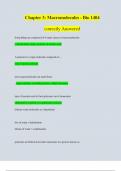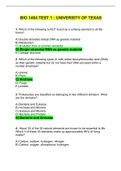Bio 1404 Study guides, Class notes & Summaries
Looking for the best study guides, study notes and summaries about Bio 1404? On this page you'll find 91 study documents about Bio 1404.
Page 3 out of 91 results
Sort by
living things are composed of 4 major classes of macromolecules -carbohydrates, lipids, proteins, & nucleic acids
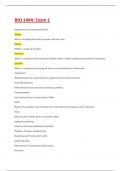
-
BIO 1404 Superior Perception.
- Exam (elaborations) • 9 pages • 2024
-
- $10.99
- + learn more
Organisms are composed of what Matter What is anything that takes up space and has mass Matter Matter is made up of what Elements What is a substance that cannot be broken down to other substances by chemical reactions Element What is a substance consisting of two or more elements in a fixed ratio Compound What elements are required by an organism to live and reproduce Essential elements What elements are required in minute quantities Trace elements Each element has a certain type ...
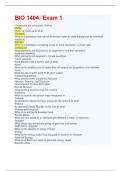
-
BIO 1404 Achieve High Grades.
- Exam (elaborations) • 6 pages • 2023
-
- $12.49
- + learn more
What elements are required by an organism to live and reproduce Essential elements What elements are required in minute quantities Trace elements Each element has a certain type of what Atom What is the smallest unit of matter that still retains the properties of an element Atom What are the smaller parts of an atom called Subatomic particles What are the three Subatomic Particles Neutron, Protons, and Electrons Neutrons and Protons form what Atomic Nucleus What forms a cloud aroun...
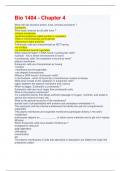
-
Bio 1404 - Chapter 4 TOP ACHIEVE
- Exam (elaborations) • 7 pages • 2023
-
- $12.49
- + learn more
What cell has domains protist, fungi, animals,and plants ? Eukaryotic What basic features do all cells have ? -plasma membrane -semiflud substance called cyotsol or cytoplasm -DNA or Chromosomes (carry genes) -ribosomes (make proteins) Prokaryotic cells are characterized as NOT having -no nucleus -no membrane bound organelles What unbound region in DNA found in prokaryotic cells? nucleoid - this is where chromosome is found In prokaryotic cells, the cytoplasm is bound by what? plasm...
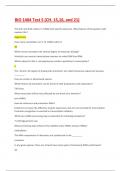
-
BIO 1404 Test 5 Superior Perception.
- Exam (elaborations) • 5 pages • 2024
-
- $9.99
- + learn more
The -10 and -35 regions of prokaryotic promoters are called consensus sequences because ________. they are similar in all bacterial species Which feature of promoters can be found in both prokaryotes and eukaryotes? TATA box What transcripts will be most affected by low levels of α-amanitin? pre-mRNAs How do enhancers and promoters differ? Enhancers increase the efficiency of gene expression, but are not essential for transcription. Promoter recognition is essential to transcription in...
BIO 1404 TEST 1,2,3 / BIO1404 TEST 1,2,3|Verified and 100% Correct Q & A.
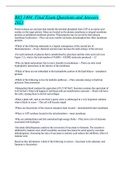
-
BIO 1404: Final Exam Questions and Answers 2023
- Exam (elaborations) • 6 pages • 2023
- Available in package deal
-
- $7.99
- + learn more
Protein kinases are enzymes that transfer the terminal phosphate from ATP to an amino acid residue on the target protein. Many are located on the plasma membrane as integral membrane proteins or peripheral membrane proteins. What purpose may be served by their plasma membrane localization - -They can more readily encounter and phosphorylate other membrane proteins -Which of the following statements is a logical consequence of the second law of thermodynamics - -Every chemical reaction must ...
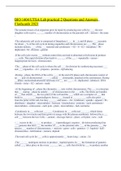
-
BIO 1404 Final Exam Questions and Answers 2023
- Package deal • 5 items • 2023
-
- $34.49
- + learn more
What separates the living cell from its surroundings - -Plasma membrane -What plasma membrane exhibits BLANK, which allows some substances to cross it more easily than others - -Selective permeability -What are the most abundant lipids in most membranes - -Phospholipids -Phospholipids are ___, containing hydrophobic and hydrophilic regions - -Am
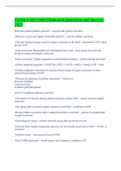
-
Bio 1404: Exam 2 Questions and Answers A Level 2023
- Package deal • 5 items • 2023
-
- $32.99
- + learn more
Protein kinases are enzymes that transfer the terminal phosphate from ATP to an amino acid residue on the target protein. Many are located on the plasma membrane as integral membrane proteins or peripheral membrane proteins. What purpose may be served by their plasma membrane localization - -They can more readily encounter and phosphorylate other m
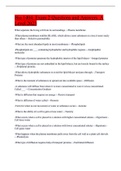
-
Bio 1404: Exam 2 Questions and Answers A Level 2023
- Exam (elaborations) • 4 pages • 2023
- Available in package deal
-
- $7.99
- + learn more
What separates the living cell from its surroundings - -Plasma membrane -What plasma membrane exhibits BLANK, which allows some substances to cross it more easily than others - -Selective permeability -What are the most abundant lipids in most membranes - -Phospholipids -Phospholipids are ___, containing hydrophobic and hydrophilic regions - -Amphipathic molecules -What type of proteins penetrate the hydrophobic interior of the lipid bilayer - -Integral proteins -What type of prot...

Do you wonder why so many students wear nice clothes, have money to spare and enjoy tons of free time? Well, they sell on Stuvia! Imagine your study notes being downloaded a dozen times for $15 each. Every. Single. Day. Discover all about earning on Stuvia

